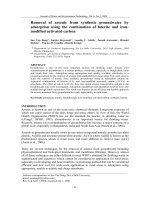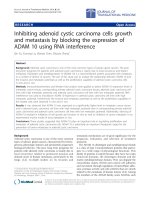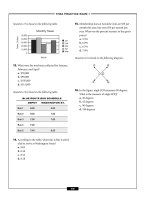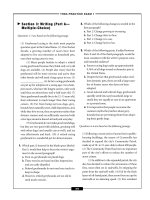Using the process of elimination 10 pps
Bạn đang xem bản rút gọn của tài liệu. Xem và tải ngay bản đầy đủ của tài liệu tại đây (61.03 KB, 6 trang )
SYMBOLS OF ADDITION
In addition, the numbers being added are called addends. The result is called a sum. The symbol for addition is
called a plus sign. In the following example, 4 and 5 are addends and 9 is the sum:
4 + 5 = 9
SYMBOLS OF SUBTRACTION
In subtraction, the number being subtracted is called the subtrahend. The number being subtracted FROM is called
the minuend. The answer to a subtraction problem is called a difference. The symbol for subtraction is called a
minus sign. In the following example, 15 is the minuend, 4 is the subtrahend, and 11 is the difference:
15 – 4 = 11
SYMBOLS OF MULTIPLICATION
When two or more numbers are being multiplied, they are called factors. The answer that results is called the prod-
uct. In the following example, 5 and 6 are factors and 30 is their product:
5 ϫ 6 = 30
There are several ways to represent multiplication in the above mathematical statement.
■
A dot between factors indicates multiplication:
5 • 6 = 30
■
Parentheses around any one or more factors indicate multiplication:
(5)6 = 30, 5(6) = 30, and (5)(6) = 30.
■
Multiplication is also indicated when a number is placed next to a variable: 5a = 30. In this equation,
5 is being multiplied by a.
S
YMBOLS OF DIVISION
In division, the number being divided BY is called the divisor. The number being divided INTO is called the div-
idend. The answer to a division problem is called the quotient.
There are a few different ways to represent division with symbols. In each of the following equivalent
expressions, 3 is the divisor and 8 is the dividend:
8 ÷ 3, 8/3,
ᎏ
8
3
ᎏ
,3ͤ8
ෆ
– THEA MATH REVIEW–
85
PRIME AND
COMPOSITE NUMBERS
A positive integer that is greater than the number 1 is either prime or composite, but not both.
■
A prime number is a number that has exactly two factors: 1 and itself.
Examples
2, 3, 5, 7, 11, 13, 17, 19, 23 . . .
■
A composite number is a number that has more than two factors.
Examples
4, 6, 8, 9, 10, 12, 14, 15, 16 . . .
■
The number 1 is neither prime nor composite since it has only one factor.
Operations
ADDITION
Addition is used when it is necessary to combine amounts. It is easiest to add when the addends are stacked in a
column with the place values aligned. Work from right to left, starting with the ones column.
Example
Add 40 + 129 + 24.
1. Align the addends in the ones column. Since it is necessary to work from right to left, begin to add start-
ing with the ones column. Since the ones column totals 13, and 13 equals 1 ten and 3 ones, write the 3 in
the ones column of the answer, and regroup or “carry” the 1 ten to the next column as a 1 over the tens
column so it gets added with the other tens:
1
40
129
+ 24
3
– THEA MATH REVIEW–
86
2. Add the tens column, including the regrouped 1.
1
40
129
+ 24
93
3. Then add the hundreds column. Since there is only one value, write the 1 in the answer.
1
40
129
+ 24
193
SUBTRACTION
Subtraction is used to find the difference between amounts. It is easiest to subtract when the minuend and sub-
trahend are in a column with the place values aligned. Again, just as in addition, work from right to left. It may
be necessary to regroup.
Example
If Becky has 52 clients, and Claire has 36, how many more clients does Becky have?
1. Find the difference between their client numbers by subtracting. Start with the ones column. Since 2 is
less than the number being subtracted (6), regroup or “borrow” a ten from the tens column. Add the
regrouped amount to the ones column. Now subtract 12 – 6 in the ones column.
5
4
2
1
– 36
6
2. Regrouping 1 ten from the tens column left 4 tens. Subtract 4 – 3 and write the result in the tens column
of the answer. Becky has 16 more clients than Claire. Check by addition: 16 + 36 = 52.
5
4
2
1
– 36
16
– THEA MATH REVIEW–
87
MULTIPLICATION
In multiplication, the same amount is combined multiple times. For example, instead of adding 30 three times,
30 + 30 + 30, it is easier to simply multiply 30 by 3. If a problem asks for the product of two or more numbers,
the numbers should be multiplied to arrive at the answer.
Example
A school auditorium contains 54 rows, each containing 34 seats. How many seats are there in total?
1. In order to solve this problem, you could add 34 to itself 54 times, but we can solve this problem easier
with multiplication. Line up the place values vertically, writing the problem in columns. Multiply the
number in the ones place of the top factor (4) by the number in the ones place of the bottom factor (4): 4
ϫ 4 = 16. Since 16 = 1 ten and 6 ones, write the 6 in the ones place in the first partial product. Regroup or
carry the ten by writing a 1 above the tens place of the top factor.
1
34
ϫ
54
6
2. Multiply the number in the tens place in the top factor (3) by the number in the ones place of the bottom
factor (4); 4 ϫ 3 = 12. Then add the regrouped amount 12 + 1 = 13. Write the 3 in the tens column and
the one in the hundreds column of the partial product.
1
34
ϫ
54
136
3. The last calculations to be done require multiplying by the tens place of the bottom factor. Multiply 5
(tens from bottom factor) by 4 (ones from top factor); 5 ϫ 4 = 20, but since the 5 really represents a
number of tens, the actual value of the answer is 200 (50 ϫ 4 = 200). Therefore, write the two zeros under
the ones and tens columns of the second partial product and regroup or carry the 2 hundreds by writing
a 2 above the tens place of the top factor.
2
34
ϫ
54
136
00
– THEA MATH REVIEW–
88
4. Multiply 5 (tens from bottom factor) by 3 (tens from top factor); 5 ϫ 3 = 15, but since the 5 and the 3
each represent a number of tens, the actual value of the answer is 1,500 (50 ϫ 30 = 1,500). Add the two
additional hundreds carried over from the last multiplication: 15 + 2 = 17 (hundreds). Write the 17 in
front of the zeros in the second partial product.
2
34
ϫ
54
136
1,700
5. Add the partial products to find the total product:
2
34
ϫ
54
136
+ 1,700
1,836
Note: It is easier to perform multiplication if you write the factor with the greater number of digits in the top row.
In this example, both factors have an equal number of digits, so it does not matter which is written on top.
DIVISION
In division, the same amount is subtracted multiple times. For example, instead of subtracting 5 from 25 as many
times as possible, 25 – 5 – 5 – 5 – 5 – 5, it is easier to simply divide, asking how many 5s are in 25; 25 ÷ 5.
Example
At a road show, three artists sold their beads for a total of $54. If they share the money equally, how
much money should each artist receive?
1. Divide the total amount ($54) by the number of ways the money is to be split (3). Work from left to right.
How many times does 3 divide 5? Write the answer, 1, directly above the 5 in the dividend, since both the
5 and the 1 represent a number of tens. Now multiply: since 1(ten) ϫ 3(ones) = 3(tens), write the 3
under the 5, and subtract; 5(tens) – 3(tens) = 2(tens).
1
3ͤ54
ෆ
–3
2
– THEA MATH REVIEW–
89
2. Continue dividing. Bring down the 4 from the ones place in the dividend. How many times does 3 divide
24? Write the answer, 8, directly above the 4 in the dividend. Since 3 ϫ 8 = 24, write 24 below the other 24
and subtract 24 – 24 = 0.
18
3ͤ54
ෆ
–3↓
24
–24
0
REMAINDERS
If you get a number other than zero after your last subtraction, this number is your remainder.
Example
9 divided by 4.
2
4ͤ9
ෆ
– 8
1
1 is the remainder.
The answer is 2 r1. This answer can also be written as 2
ᎏ
1
4
ᎏ
since there was one part left over out of the
four parts needed to make a whole.
Working with Integers
Remember, an integer is a whole number or its opposite. Here are some rules for working with integers:
ADDING
Adding numbers with the same sign results in a sum of the same sign:
(positive) + (positive) = positive and (negative) + (negative) = negative
When adding numbers of different signs, follow this two-step process:
1. Subtract the positive values of the numbers. Positive values are the values of the numbers without any
signs.
2. Keep the sign of the number with the larger positive value.
– THEA MATH REVIEW–
90









